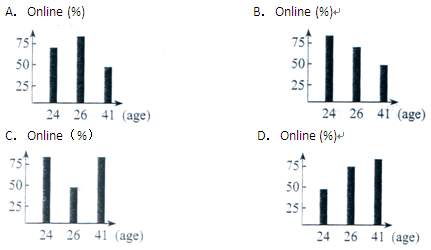题目内容
A study shows that about two-thirds of typical Chinese Internet users use the computer for news,often entertainment-related, or for online games, music or movies, all of which can be downladed for free. Most people prefer messages to e-mails, and seldom do online shopping at all.
Although they are now depending on the Internet more often than before to communicate with others who have the same professions, hobbies and interests, online shopping still remains unpopular in China. Three-quarters of users surveyed have never bought anything over the Internet, and 10 percent do shopping even once a month.Among those who do buy online.most pay for entertainment while others buy phone cards, or computer hardwares or so of iwares.
"Many people don't trust the quality of goods bought online," the researcher said. "If they buy something in a store and don't like it, they can easily bring it back."
The survey was done in Beijing, Shanghai, Guangzhou, Chengdu and Changsha. There-
sults do not necessarily show the situation countrywide because internet use in the countryside is lower than in cities. The study showed that the typical netizensc网民) in the five cities are richer and more highly educated. Males make up two-thirds of the group, and more than 80 percent of users are under 24. As the age increases, the percentage of netizens decreases.
China has more than 20 million people online, however, forty-two percent say they do not use search engines.Others seek entertainment news, as well as information useful for work or study online. Baidu.com is used by half of those surveyed, compared with a quarter for Go-ogle, the leading search engine in the United States.
【小题1】The passage is mainly about .
| A.shopping online | B.Internet use in China |
| C.the typical Chinese netizens | D.popular search engines |
| A.likes to send e-mails | B.likes to buy goods online |
| C.likes to pay for entertainment | D.likes the games sites |
| A.it is more difficult to return the goods |
| B.most people haven't got computers |
| C.people can't have a look at the goods |
| D.goods bought online are of good quality |
| A.Well educated. | B.Richer. | C.Female. | D.Young. |

【小题1】B
【小题2】D
【小题3】A
【小题4】C
【小题5】B
解析试题分析:
【小题1】B 主旨大意题,本文主要讲述的是一项对中国网民情况的调查。故B正确。
【小题2】D 细节题。根据第一段第一行A study shows that about two-thirds of typical Chinese Internet users use the computer for news,often entertainment-related, or for online games, music or movies说明中国的网民经常会玩游戏,那么他们会比较喜欢游戏网站。故D正确。
【小题3】A 推理题。根据第三段第二句"If they buy something in a store and don't like it, they can easily bring it back."说明他们在商店里买的东西很容易就推了回去,可能在网上的东西退货不太方便。故A正确。
【小题4】C 细节题。根据第四段2,3行The study showed that the typical netizensc网民) in the five cities are richer and more highly educated. Males make up two-thirds of the group, and more than 80 percent of users are under 24.说明ABD都是大城市网民的特点,C不是。
【小题5】B 推理题。根据第四段最后一行As the age increases, the percentage of netizens decreases.说明年龄越大上网越少,构成反比关系,故B正确。
考点:考查新闻类短文阅读
点评:本文主要讲述的是一项对中国网民情况的调查。本文内容较为复杂,要求考生认真审题,仔细辨析选项。如70题就是根据文章中的第四段最后一行,说明存在着反比的关系。

 举一反三同步巧讲精练系列答案
举一反三同步巧讲精练系列答案 口算与应用题卡系列答案
口算与应用题卡系列答案 名师点睛字词句段篇系列答案
名师点睛字词句段篇系列答案 d student learning. “I think half of them fell off their chairs,” Gerner says.
d student learning. “I think half of them fell off their chairs,” Gerner says. chnologies that you get are impractical. I’m interested in those that work.” But he wouldn’t mind if some green features inspire students. He says he hopes to set up green energy systems that allow them to learn about the process of harvesting wind and solar power. “You never know what’s going to start the interest of a child to study math and science,” he says.
chnologies that you get are impractical. I’m interested in those that work.” But he wouldn’t mind if some green features inspire students. He says he hopes to set up green energy systems that allow them to learn about the process of harvesting wind and solar power. “You never know what’s going to start the interest of a child to study math and science,” he says.